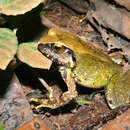mk
имиња во трошки


Arthroleptis adolfifriederici és una espècie de granota que viu a Burundi, República Democràtica del Congo, Kenya, Ruanda, Tanzània i Uganda.
Es troba amenaçada d'extinció per la pèrdua del seu hàbitat natural.
Arthroleptis adolfifriederici és una espècie de granota que viu a Burundi, República Democràtica del Congo, Kenya, Ruanda, Tanzània i Uganda.
Es troba amenaçada d'extinció per la pèrdua del seu hàbitat natural.
Arthroleptis adolfifriederici is a species of frog in the family Arthroleptidae. It is found in the eastern Democratic Republic of the Congo, Rwanda, Burundi, and Uganda.[1][2] Several common names have been coined for it, including Rugege Forest squeaker, Rugegewald squeaker, Adolf Friedrich's squeaker frog, and Adolf's squeaker.[2]
The specific name adolfifriederici is named for Duke Adolf Friedrich of Mecklenburg, German explorer and colonial politician,[3] based on the "stately form" of the species.[4]
Arthroleptis adolfifriederici is a moderately robust frog with long, slender limbs. Males measure 28–32 mm (1.1–1.3 in) (two specimens only) and females 30–43 mm (1.2–1.7 in) in snout–vent length. The head is broad. The tympanum is distinct and circular, tending toward ovoid. The fingers and toes do not have webbing but the toes have prominent subarticular tubercles. Skin is generally glandular. Color in preservative (alcohol) is light to medium brown with small, dark-brown spots.[4]
It can be found in leaf litter of montane forests (including bamboo forests) at elevations of 1,780–2,815 m (5,840–9,236 ft) above sea level. It has also been recorded at the edge of human-modified forests following land clearance for agriculture. It appears to be an uncommon species. It is threatened by forest loss due to agriculture, timber cutting, and human settlements. It occurs in many protected areas, including the Nyungwe Forest National Park in Rwanda and Bwindi Impenetrable Forest in Uganda.[1]
Arthroleptis adolfifriederici is a species of frog in the family Arthroleptidae. It is found in the eastern Democratic Republic of the Congo, Rwanda, Burundi, and Uganda. Several common names have been coined for it, including Rugege Forest squeaker, Rugegewald squeaker, Adolf Friedrich's squeaker frog, and Adolf's squeaker.
Arthroleptis adolfifriederici es una especie de anfibios de la familia Arthroleptidae. Habita en Burundi, República Democrática del Congo, Kenia, Ruanda, Tanzania y Uganda. Sus hábitats naturales son bosques tropicales o subtropicales, montanos secos tropicales o subtropicales y zonas antiguamente boscosas ahora degradadas. Está amenazada de extinción por la pérdida de su hábitat natural.
Arthroleptis adolfifriederici es una especie de anfibios de la familia Arthroleptidae. Habita en Burundi, República Democrática del Congo, Kenia, Ruanda, Tanzania y Uganda. Sus hábitats naturales son bosques tropicales o subtropicales, montanos secos tropicales o subtropicales y zonas antiguamente boscosas ahora degradadas. Está amenazada de extinción por la pérdida de su hábitat natural.
Arthroleptis adolfifriederici Arthroleptis generoko animalia da. Anfibioen barruko Arthroleptidae familian sailkatuta dago, Anura ordenan.
Arthroleptis adolfifriederici Arthroleptis generoko animalia da. Anfibioen barruko Arthroleptidae familian sailkatuta dago, Anura ordenan.
Arthroleptis adolfifriederici est une espèce d'amphibiens de la famille des Arthroleptidae[1].
Cette espèce se rencontre dans les montagnes des Virunga dans l'Est du Congo-Kinshasa, au Rwanda, au Burundi et au Sud-Ouest de l'Ouganda[1].
Les autres populations d'Afrique de l'Est qui étaient considérées comme appartenant à cette espèce appartiennent à d'autres espèces[2].
Cette espèce est nommée en l'honneur d'Adolphe-Frédéric de Mecklembourg[3].
Arthroleptis adolfifriederici est une espèce d'amphibiens de la famille des Arthroleptidae.
Arthroleptis adolfifriederici Nieden, 1911 è un anfibio anuro, appartenente alla famiglia degli Artroleptidi.[2][3]
L'epiteto specifico è stato dato in onore di Adolfo Federico di Meclemburgo-Schwerin.[4]
Popolazioni isolate si trovano nelle foreste montane nell'estremo est della Repubblica Democratica del Congo, in Ruanda, Burundi e Uganda sudoccidentale.[3] Altre popolazioni dell'Africa orientale considerate appartenenti a questa specie sono state attribuite ad altre.[5]
IUCN, Conservation International, and NatureServe, 2004, Global Amph. Assessment suggeriva che le segnalazioni del Camerun fossero di un'altra specie, ora identificata con Arthroleptis perreti. Le segnalazioni da Kenya e Tanzania apparentemente si riferiscono ad Arthroleptis affinis.[3]
Arthroleptis adolfifriederici Nieden, 1911 è un anfibio anuro, appartenente alla famiglia degli Artroleptidi.
Arthroleptis adolfifriederici là một loài ếch thuộc họ Arthroleptidae. Loài này có ở Burundi, Cộng hòa Dân chủ Congo, Kenya, Rwanda, Tanzania, và Uganda. Môi trường sống tự nhiên của chúng là rừng ẩm vùng đất thấp nhiệt đới hoặc cận nhiệt đới, vùng núi ẩm nhiệt đới hoặc cận nhiệt đới, và rừng thoái hóa nghiêm trọng. Chúng hiện đang bị đe dọa vì mất môi trường sống.
Arthroleptis adolfifriederici là một loài ếch thuộc họ Arthroleptidae. Loài này có ở Burundi, Cộng hòa Dân chủ Congo, Kenya, Rwanda, Tanzania, và Uganda. Môi trường sống tự nhiên của chúng là rừng ẩm vùng đất thấp nhiệt đới hoặc cận nhiệt đới, vùng núi ẩm nhiệt đới hoặc cận nhiệt đới, và rừng thoái hóa nghiêm trọng. Chúng hiện đang bị đe dọa vì mất môi trường sống.
Arthroleptis adolfifriederici Niedenruen, 1911
ПодвидыТучная пискунья[1] (лат. Arthroleptis adolfifriederici) — вид бесхвостых земноводных из семейства пискуний. Обитают в горных областях восточной Демократической Республики Конго (в Вирунга), Руанды, Бурунди, юго-западной Уганды, юго-восточной Кении (на возвышенности Таита — Taita Hills (англ.)) и Танзании (в горах Усамбара и Улугуру и южных высокогорьях Southern Highlands, Tanzania (англ.))[2]. Живут среди опавшей листвы в горных лесах[2].
Тучная пискунья (лат. Arthroleptis adolfifriederici) — вид бесхвостых земноводных из семейства пискуний. Обитают в горных областях восточной Демократической Республики Конго (в Вирунга), Руанды, Бурунди, юго-западной Уганды, юго-восточной Кении (на возвышенности Таита — Taita Hills (англ.)) и Танзании (в горах Усамбара и Улугуру и южных высокогорьях Southern Highlands, Tanzania (англ.)). Живут среди опавшей листвы в горных лесах.